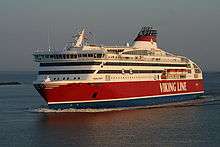MS Viking Grace
 Viking Grace in Ruissalo, Finland, on 9 June 2013 | |
| History | |
|---|---|
| Name: | Viking Grace |
| Owner: | Viking Line |
| Port of registry: |
Mariehamn, |
| Route: | Turku–Mariehamn–Stockholm |
| Ordered: | 22 December 2010[2] |
| Builder: | STX Europe Turku Shipyard, Finland |
| Cost: | 240 million euro (estimate)[2] |
| Yard number: | 1376[3] |
| Laid down: | 6 March 2012 |
| Launched: | 10 August 2012[1] |
| Completed: | 10 January 2013 [1] |
| Maiden voyage: | 13 January 2013[1] |
| In service: | 2013–Present |
| Identification: | IMO number: 9606900Call sign: OJPQ MMSI number: 230629000 |
| Status: | In service |
| General characteristics | |
| Type: | Cruiseferry |
| Tonnage: | 57,565 GT[4] |
| Length: | 218 m (715 ft 3 in) |
| Beam: | 31.8 m (104 ft 4 in) |
| Ice class: | 1A Super[2] |
| Installed power: | 4 × Wärtsilä 8L50DF (4 × 7,600 kW)[5] |
| Propulsion: |
Two shafts, fixed pitch propellers |
| Speed: | 22 knots (41 km/h; 25 mph)[1] |
| Capacity: |
2,800 passengers[2] 1,275 lane meters for ro-ro cargo 1,000 lane meters for cars[1] |
| Crew: | 200[2] |

MS Viking Grace is a cruiseferry constructed at STX Europe Turku Shipyard, Finland for the Finland-based ferry company Viking Line. The ship was delivered to her owners on 10 January 2013, and took service on 13 January 2013. It is the first large scale passenger ferry to be powered by liquefied natural gas (LNG).[6]
Construction
Construction on the ship started on 28 November 2011. On 17 February 2012, the ship's name was revealed as Viking Grace.
Principal Particulars
The ferry MS Viking Grace has length of 218 m (715 ft 3 in), beam of 31.8 m (104 ft 4 in) and maximum summer draft of 6.80 m (22 ft 4 in). The ship has deadweight of 6,107 DWT and gross tonnage of 57,565 GRT, which gives maximum passenger capacity for 2,800 people. The vessel has 880 rooms, restaurants, bars, spa and shopping centers. Also on board of MS Viking Grace there are 1,000 m for cars and 1,275 m for storage of Ro-Ro cargo.
Decks
- Deck 1: Engine room, crew spaces
- Deck 2: Engine room, crew spaces
- Deck 3: Car deck
- Deck 4: Car deck
- Deck 5: Car deck, S4, I4, IP2 and DRIVER-cabins
- Deck 6: SD2, ID2, S4, I4, IH4, DH4, SH4, SF6 and IF6-cabins
- Deck 7: SU3, SU4, PREMIUM, SD2, ID3, S4, I4, I2, IH4, S4R and I4R-cabins
- Deck 8: Su1, Su2, PREMIUM, SD2, ID2, S4, I4, I2, IH4 and IP2-cabins
- Deck 9: PREMIUM, ID2, SH3, IP2-cabins, Shopping World, Teens, Arcade, Information desk and Conference Center
- Deck 10: Buffet Aurora, Café Sweet & Salty, Retro Bar & Dancing, Rockmore Bar, Playroom, Casino, Club Vogue (first floor), Sun deck
- Deck 11: A la carte Oscar, Seamore Champagne Lounge, Wine Shop, Frank's Casual Dining, SPA Wellness, Club Vogue (second floor), Sun deck
- Deck 12: Sun deck
Engineering
The ferry MS Viking Grace is modern and high-tech vessel, which is driven by four diesel/gas electric engines Wartsila 8L50DF, each with power of 10,100 hp. MS Viking Grace is the first passenger ship, which is LNG fueled with higher efficiency and lower fuel consumption. The Cruise ferry Viking Grace is also the first ship, which install turbosail for hybrid usage of wind power.[7] The new technology is called Rotor Sail Solution and developed by the Finnish company Norsepower and already proved its economic efficiency.
On board of the ferry will be installed rotor cylinder with height of 24.00 m and a width of 4.00 m. During the operations, the cylinder rotates around its and receives additional power from the airflow. Such propulsion was developed and patented by the German engineer Anton Flettner in 1922. MS Viking Grace will become the first ferry, which uses hybrid the wind power and diesel/gas engine.
- MS Viking Grace under construction at STX Europe Turku Shipyard, Finland.
- Funnel of Viking Grace.
- Bridge of Viking Grace.
- Paintings of Viking Grace.
- Decks of Viking Grace.
References
- 1 2 3 4 5 6 M/S Viking Gracen vesillelasku. Viking Line, 10 August 2012. Retrieved 2012-08-10.
- 1 2 3 4 5 "Viking Line NB 1376" (PDF). Retrieved 2012-01-23.
- ↑ "NB 1376.com". Retrieved 2012-01-23.
- ↑ "Marine Traffic Viking Grace". Retrieved 2016-10-05.
- ↑ Viking Grace. Wärtsilä. Retrieved 2012-07-13.
- ↑ http://www.iltalehti.fi/uutiset/2013011316550074_uu.shtml
- ↑ http://www.maritimeherald.com/2017/cruise-ferry-viking-grace-install-turbosail-for-hybrid-usage-of-wind-power/
External links
-
 Media related to Viking Grace (ship, 2013) at Wikimedia Commons
Media related to Viking Grace (ship, 2013) at Wikimedia Commons - Viking Grace Video Clips
- Viking Grace by ShipsReviews.com
